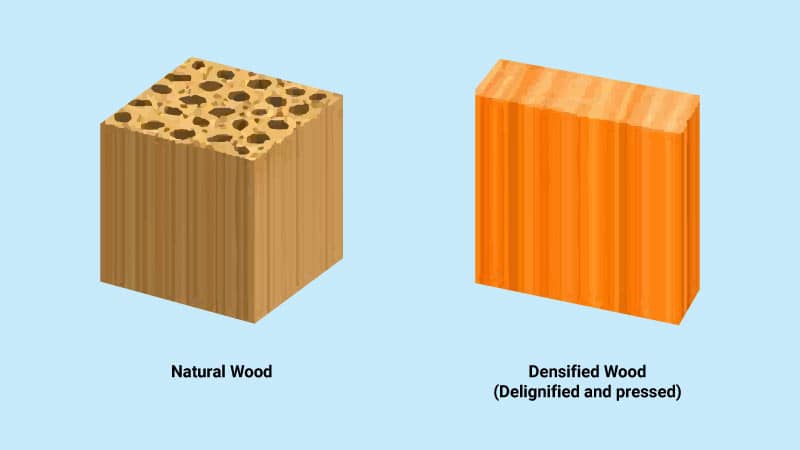In a modern world replete with high tech materials like aerogels, carbon fibers and metal alloys, it’s easy to overlook something as commonplace as wood. However, lowly lumber doth offer myriad advantages: Chiefly it can be grown, making it sustainable and cheap; it’s also familiar, easy to work with, aesthetically pleasing and biodegradable. For all these reasons, researchers are looking for ways to improve wood using state-of-the-art nanotechnologies.
Published in Nature last year, scientists at the University of Maryland led by Liangbing Hu, reported a simple process that triples the density of any type of wood, making it 11.5 times as strong. To make this high density “super wood” the researchers first soaked normal wood in a bath of sodium hydroxide (NaOH) and sodium sulfite (Na2SO3). These two chemicals work in tandem to remove some of the lignin and hemicellulose—two abundant polymers found in the cell wall—in the wood.
Then the wood is heated and compressed. With the lignin and hemicellulose removed, the cell walls in the wood collapse completely and the remaining cellulose fibers—a third important polymer in wood—are tightly compacted into nanofibers. “Partial removal of lignin enables high compression to 80% volume reduction,” says Dai Jiaqi, one of the researchers on Hu’s team. “Natural pores inside wood are closed, resulting in higher density, more hydrogen bonding, thus stronger mechanical strength,” says Jiaqi.

The final product is a piece of lumber that boasts higher tensile strength than most metals, but is far lighter. Five layers of the stuff could even stop a bullet nearly as well as Kevlar, potentially paving the way for cheap, lightweight body armor.
But the super wood’s benefits don’t stop there. Last month Hu’s team published a new study—this time in Science—that showed how the same process of removing lignin can also make wood super reflective, bouncing back nearly 100% of visible light and only absorbing a tiny bit of near-infrared radiation.
The result is a material that is cooler than ambient temperatures even when placed in direct sunlight. If used in buildings, the team calculates that the super wood could result in energy savings between 20% and 60%, with the highest gains occurring in hot dry climates where the cost of air conditioning is often at a premium.
Since the initial publication in Nature, Hu and his team have been inundated with calls asking about the new technology. The attention would ultimately lead to the foundation of InventWood, a company focused on bringing these technologies from the laboratory into the real world—a goal that company CEO Josh Cable says they’re hoping to realize in the next 9-12 months. The company has already received support from the US Department of Energy, including an ARPA-E grant to fund additional research into ways to incorporate the super wood into vehicles as a replacement for carbon fiber and steel. Cable says the interest they’re receiving comes mostly from “large firms in the automotive, aerospace, building/construction, and/or industrial sectors” and that “discussions with large, multi-national firms in these market segments are currently underway.”
The future cost structure for the super wood will depend on size, form and required treatment according to Cable, but the company’s ultimate goal is to make the product competitive with existing technologies. If they can achieve that, the most high-tech material in your next car or house might not be carbon fiber or titanium, but good old-fashioned wood.











